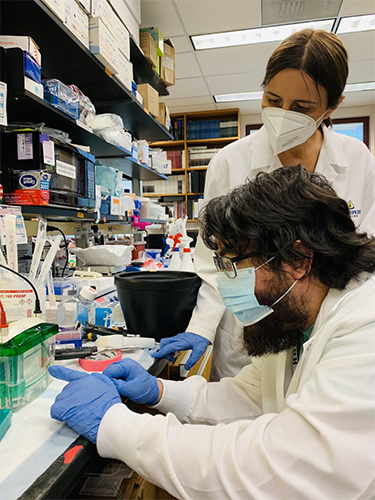- The Yersinia family of bacteria, which includes the bacterium that causes bubonic plague, can cause infections that are difficult for the human immune system to clear and can result in complications such as reactive arthritis.
- Researchers have discovered how these bacteria interrupt cells’ ability to send lipid-based signals that alert the immune system to a threat.
- These findings help explain why it is hard for the body to get rid of these infections on its own. The research also opens doors to possible therapeutic treatments for these infections.
GAINESVILLE, Fla. — New research from the University of Florida explains how a family of bacteria called Yersinia infects the body so successfully.
Yersinia bacteria, a family that includes the bacterium responsible for bubonic plague, is able go undetected by interrupting communication between immune system cells and the site of the infection, the researchers showed. This communication is normally mediated by specific lipids.

“We showed how Yersinia reduces the ability of an infected cell to produce a lipid called prostaglandin E2. With any bacterial infection, this lipid tells the immune system that there is a threat, but in the case of Yersinia, this communication is missing,” said Mariola Edelmann, senior author of the study and an assistant professor in the UF/IFAS department of microbiology and cell science.
“While non-steroidal anti-inflammatory drugs such as ibuprofen typically are used to block overstimulation of prostaglandin E2 production, we propose that for some infections, a moderate production of this lipid is helpful for clearance of the infection,” Edelmann added.
In effect, by blocking prostaglandin E2 synthesis, Yersinia takes away infected cells’ ability to call for help, the researchers said. Until now, scientists did not know how the bacteria were able to do this at a molecular level.
“Yersinia has a ‘secretion system,’ which is like a tiny needle the bacterium uses to introduce a set of specific enzymes into a cell, including the one that stops the cell from making prostaglandin E2,” said Austin Sheppe, first author of the study and a former graduate student in Edelmann’s lab. Sheppe earned his doctorate from the UF/IFAS College of Agricultural and Life Sciences (CALS) in 2021 and currently works as a post-doctoral associate in Dr. Aria Eshraghi’s laboratory in the UF College of Veterinary Medicine’s department of infectious diseases and immunology.
A recent review study, authored by Sheppe and Edelmann, discussing the role of prostaglandins in immune response is published in the journal “Infection and Immunity.”
Altering the production of prostaglandins to evade the immune system is unique to the Yersinia family, which includes three closely related strains: Yersinia enterocolitica and Yersinia pseudotuberculosis, which are foodborne and cause gastrointestinal illness; and Yersinia pestis, which causes bubonic plague, the same disease that killed millions in Europe during the Middle Ages.
For safety purposes and cost effectiveness, the researchers only conducted their experiment with Y. enterocolitica and Y. pseudotuberculosis. However, the molecular features that allow these Yersinia strains to interrupt communication with the immune system are also found in Y. pestis.
“Previous research shows that the human immune system has a hard time detecting and clearing Yersinia infections, but the precise mechanism was unknown,” Edelmann said. “Our findings suggest that Yersinia bacteria’s ability to dodge the immune system by avoiding the production of prostaglandin E2 may be what make them so problematic.”
Fortunately, unlike people living during the Middle Ages, people today can combat Yersinia bacteria with antibiotics. However, with antibiotic resistance on the rise, plus the fact that Y. enterocolitica causes more than 100,000 cases of foodborne illnesses a year, understanding how these bacteria operate opens doors to new treatments, Edelmann said.
“Our next step is study therapeutics that can counteract the way that Yersinia interrupts the production of prostaglandin E2. We are interested in investigating a synthetic version of the lipid, ways to inhibit the enzyme the bacteria use or make it so the lipid that is produced lasts longer,” Edelmann said.
In addition to Edelmann and Sheppe, the study’s co-authors include John Santelices, a UF/IFAS CALS doctoral student studying microbiology and cell science LS, and Daniel Czyz, assistant professor of microbiology and cell science.
The study is published in the journal “Microbiology Spectrum.”
 0
0
